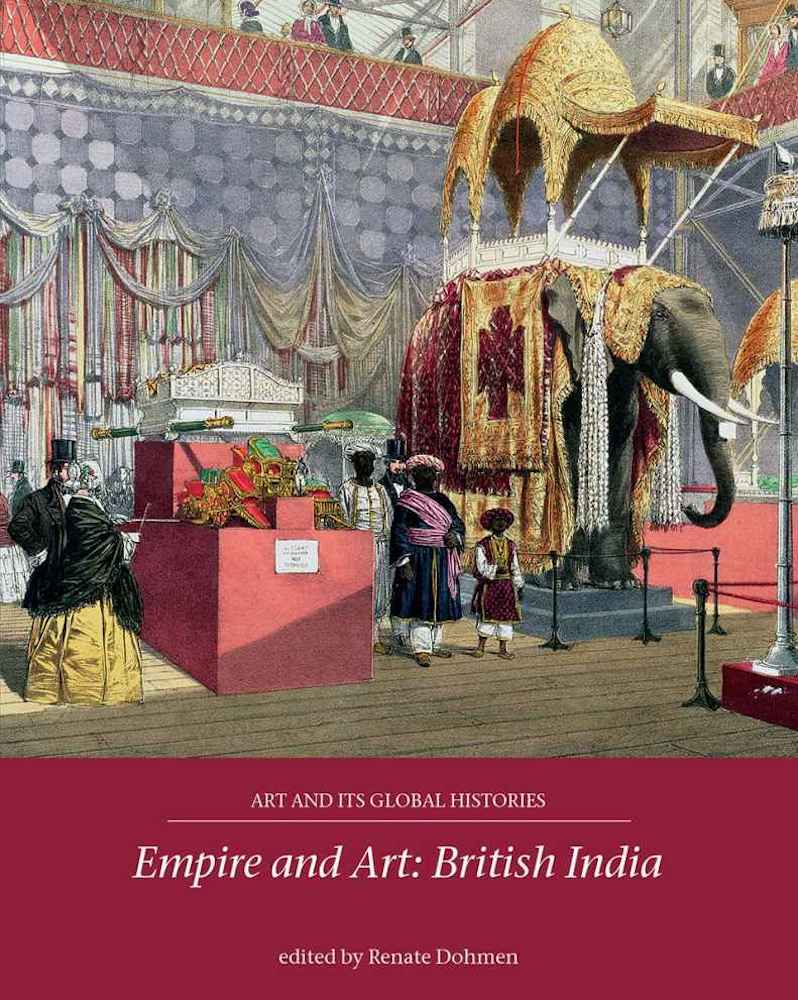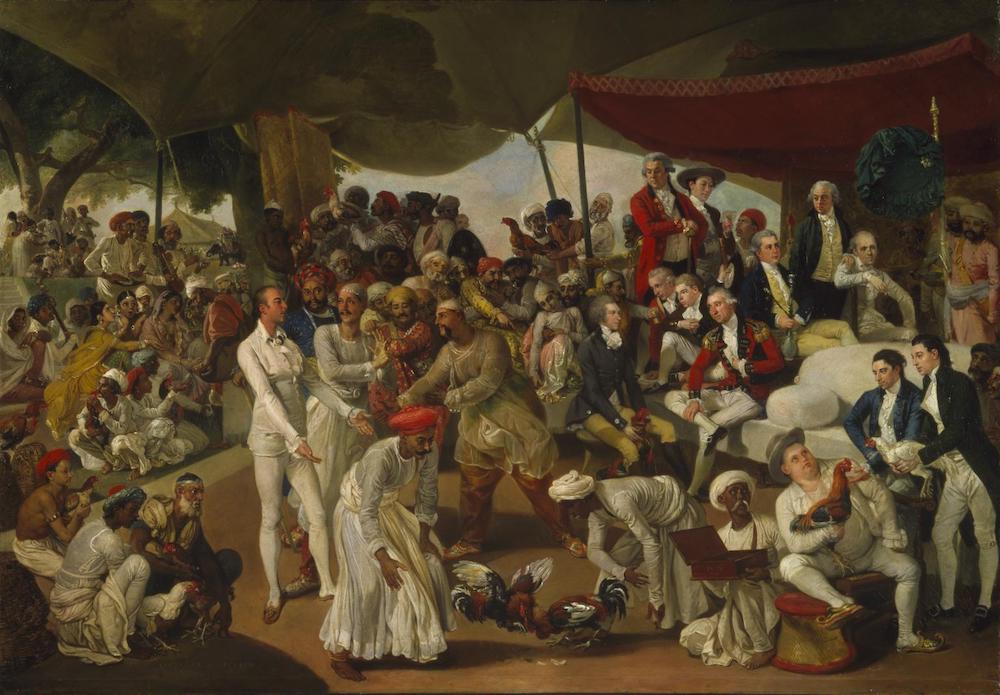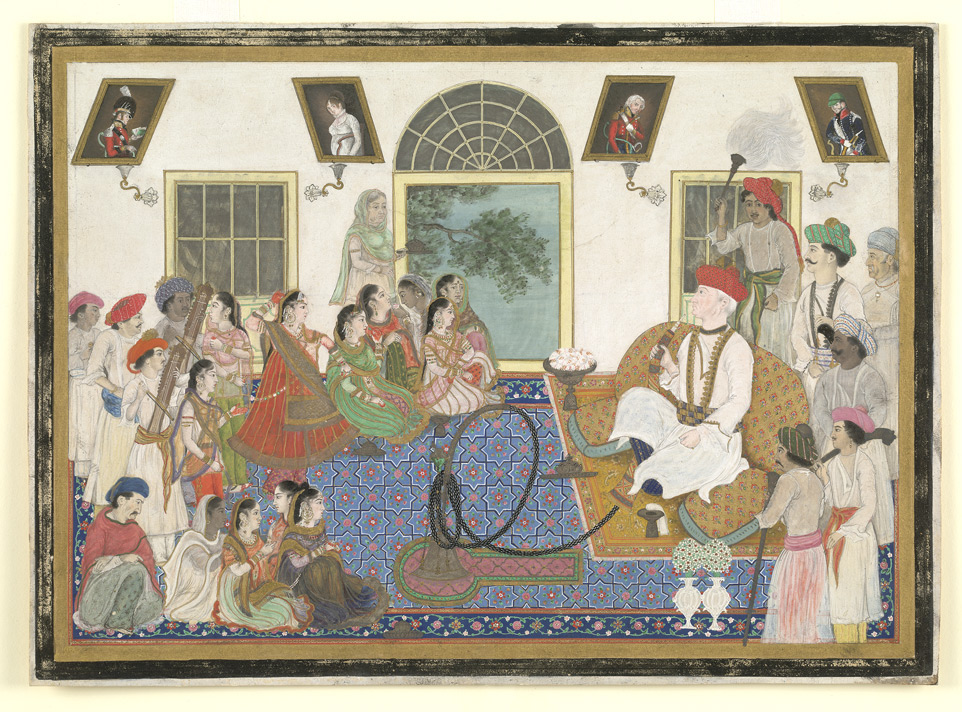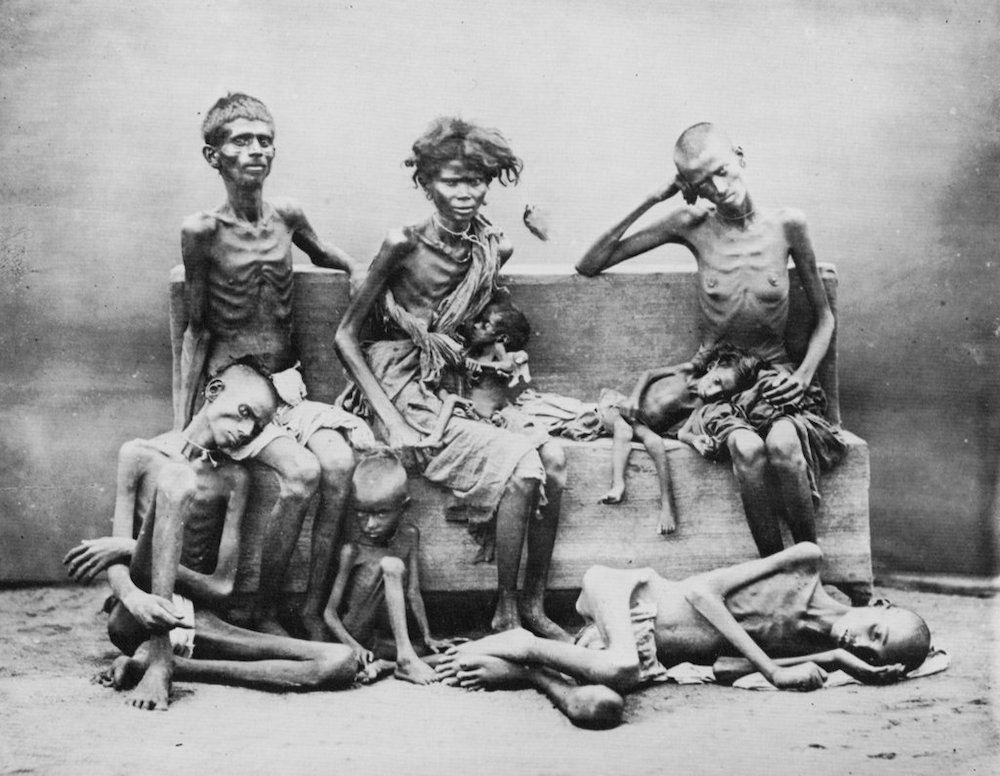The images in this review come from various sources. Please click on them to enlarge them, and in some cases for more information about them. Please also note the terms on which they can be reproduced.

Cover of the book under review.
Empire and Art: British India is a book in the "Art and Its Global Histories" series published by Manchester University Press for the Open University. Aimed specifically at undergraduates, it includes several brief "exercise" and "discussion" sections. But it is much more than an accessible, comprehensive and thought-provoking introduction to its subject. Its scope alone is exciting: as well as editing and introducing it, Renate Dohmen has written the first two wide-ranging chapters on (respectively) "Painting, prints and popular art in British India" and "Design reform, Indian crafts and empire." After these come two further, substantial chapters: Steve Edwards's "Photography in colonial India," and Elizabeth McKellar's "Building the British imperial world 1900-1939: the architecture of New Delhi."
Referring in her introduction to social theorists and orientalists like Ashish Nandy, Edward Said and Homi Bhabha, Dohmen makes it clear that neither the artists considered here, nor their audiences past or present, are looking at each other with detachment. The artwork and photographic "records" that illustrate the text do not depict objectively another culture (or rather, cultures), and the reader is helped to recognise this. The British, once having sent out traders and missionaries to India, have been subject to complex, fluid and dynamic influences from it, which continue to affect them to this day. On the other side too there have been various assimilations, and, with the dawn of modernism, rejections, reappropriations and fresh starts.


Left: George Stubbs's A Cheetah and a Stag with Two Indian Attendants (c.1764). © Manchester Art Gallery. Right: Johan Zoffany's Colonel Mordaunt's Cock Match (c. 1784-86). © Tate. Both images are available on the Creative Commons Attribution-NonCommercial-NoDerivatives licence.
Among the best known paintings reproduced in Chapter I are George Stubbs's A Cheetah and a Stag with Two Indian Attendants (c.1764), and Johan Zoffany's Colonel Mordaunt's Cock Match (c. 1784-86). The one shows the east, as it were, in England: despite its Indian handlers' best efforts, a cheetah brought over from India is no match for a British stag (as was in fact the case in the incident which this records). The other shows the English in the east, in another scene of baiting. The men stand out from, yet mingle with, a boisterous Indian crowd in "a cluttered pictorial organisation ... unusual for Zoffany" (41). Each painting, in its different way, reflects the tensions and unpredictable effects of the East-West encounter.

Sir David Ochterlony in Indian dress and smoking a hookah and watching a nautch in his house in Delhi. © British Library Online Gallery, reproduced here by kind permission. Please see the Library's own site for conditions of reuse.
There was, of course, a type of art in India which consciously blended the different traditions: Company art, defined here as "an umbrella term for the mixed styles that evolved when Indian artists, mostly from Mughal ateliers, were employed by EIC officials" (35). Although brief, Dohmen's discussion is usefully layered: she points out that Mughal art itself had absorbed many different elements — including earlier European ones. In one of the Company paintings reproduced here, Sir David Ochterlony is shown smoking a hookah in Indian costume, against a background which combines some gestures towards European perspective with a swathe of distinctly Mughal geometric patterning. Both subject and composition represent an arresting fusion of traditions. In a particularly fascinating section, Dohmen shows how this fusion carried through into the market-place, where the bold, bright and often satirical Kalighat paintings were peddled in the mid-Victorian period, and helped to link indigenous traditions with new forms — woodblock prints, for example.
The Company artist, restricted to working for his patron, would need to focus flatteringly on European figures. The landscapes of William Hodges (1744-1797), topographical scenes like the aquatints of the uncle and nephew Thomas and William Daniell (1749-1840, and 1769-1837), prints and even photographs, might serve the Company's purpose more subtly. Depicting fashionably picturesque scenes made India look not only more homely, but peaceful and well-ordered under British governance; showing ruined temples, tombs and monuments, while also being fashionable at this time, had the additional advantage of emphasizing the decay of earlier cultures. Even more obvious in its message is Thomas Daniell's Gate of the Tomb of the Emperor Akbar in Secundru, near Agra (1795), in which a British military encampment is spread diagonally across the middle of the scene.


Left: Jaina Tower at Cheetore, from a sketch by James Fergusson. Right: One of Willoughby Wallace Hooper's photographs of those stricken by the Madras Famine of 1876-78 (public domain, from Wikipedia).
Ulterior motives may be found in the choice of subjects by photographers. In Chapter 3, the pitiful shots of the victims of the Madras Famine might seem intended to evoke sympathy — especially when juxtaposed with the sacks of grain at the shore, ready for export. But do they really tug at the heart-strings? Steve Edwards suggests that the photographer, Captain Willoughby Wallace Hooper (1837-1912), might have been more interested in indulging "morbid curiosity" or reinforcing "a sense of of Christian superiority and British pre-eminence" (125) by showing people in this extremity. If so, it is another dreadful indictment of the colonial mentality. So-called "salvage photography," or photography aiming to record "types" that were thought likely to disappear with time, comes under fire here too. After all, the very premise here is that appearance alone is a marker of worth. Besides, the subjects of such collections were robbed of all natural dignity by the poses they were required to take, and by their expressionless faces. In short, here too the human being was dehumanised. Photographs of grand occasions could also assert British superiority, elevating those who represent the "civilising" colonial presence.
To twenty-first century eyes, even British photographic records of monuments seem not only to suggest a lost past, but a racialist attitude. The architectural historian James Fergusson launched a furious attack on the first Indian "Indologist," Rajendralal Mitra (1822-1891), for inferring a high level of cultural development in India in pre-classical times. Mitra and his team were engaged in similar recording projects, but the British could not accept their findings as evidence of a "golden age" of refined craftsmanship in ancient India. It hinted at a competence that no one cared to admit.

Hindoo Ornament no. 3: Ornaments from the collection at the India-House, shown in Owen Jones's The Grammar of Ornament (1856).
After so many indications of deep-rooted, fiercely maintained prejudice, it might seem a welcome relief to turn to the arts and crafts of the subcontinent. These, indeed, were much admired at the time — for example, at the Great Exhibition of 1851 itself (as shown on the book cover) or the Colonial and Indian Exhibition of 1886, which was held as part of Queen Victoria's Golden Jubilee celebrations. Here the industrialised west could see the perfect antidote to soulless mechanisation: the carving of the enormous Gwalior Gate alone (now hidden behind other exhibits at the V&A) had engaged the artistry of as many as two thousand Indian stone-carvers. There is no doubt that excitement generated by such work contributed to the Arts and Crafts Movement that was already flourishing in Victorian Britain. Dohmen also shows how British ideas were exported to India, and helped shape the new work that was being done there — a good example of the "transcultural mediations" to which she refers in her brief conclusion (180).
But, alas, examples of "British appropriation and reinvention of traditional Indian designs" (82) provide a sour note even here, and racialism could still intrude. Ruskin, for example, referring to the geometric patterning of some of the designs praised and disseminated by Owen Jones in his Grammar of Ornament, said in a lecture of 22 February 1859, "the fancy of delicacy and eye in interweaving lines and arranging colours — mere line and colour, observe, without natural form — seems to be somehow an inheritance of ignorance and cruelty" ("The Unity of Art," qtd. in Dohmen 78). Paradoxically, then, such work could sometimes be seen as an expression of the baser rather than the finer side of human nature.

The Viceroy's House (Rashtrapati Bhavan), designed by Sir Edwin Lutyens (photograph of a painting or print inside the entrance lobby).
In India, nowhere is the complicated jostling over artistic ground more clearly seen than in the planning of the new capital in Delhi. Dohmen has a good section on Anglo-Indian styles of architecture in her chapter on design, which includes, along with some Indian architects, the outstanding work of Frederick Stevens in Mumbai, and Sir Samuel Swinton Jacob in Bikaner and Jaipur. Now, Elizabeth McKellar focuses on Edwin Lutyens and Herbert Baker, and considers the grand designs that, in a neat reversal of colonial appropriations, have since been reappropriated by an independent India. After so much here that is fascinating, informative but disconcerting, McKellar's final paragraphs lift the spirits. Inevitably, the legacy of British architects in this and other Indian cities recalls an "imposed Western legacy" (175): yet in time this too is becoming embedded in a longer, richer history of cultural exchange. As she puts it herself, "colonial spaces and buildings.... through their very survival, reveal layers of history and ideology in the city in a continuing and evolving dialogue between past and present, and between different places in the post-colonial world" (175).


Left: Late Afternoon, by Mortimer Menpes. Right: Detail from Walter Crane's Imperial Federation Map, 1886.
In such a comprehensive survey, only a selection of the British artists who visited or lived in India could be discussed fully here, and some are not discussed at all. The well-known "Imperial Assemblage" painting by Valentine Prinseps is reproduced in the introduction, but no mention is made of his portraits of individual Indians. Mortimer Menpes's compelling, characterful and often affectionate portraits are overlooked too. So are several noteworthy British architects, such as Walter Granville, Robert Fellowes Chisholm and Henry Irwin. It is worth pointing out that their works in other major Indian cities have also been happily reappropriated.
The artist and designer Walter Crane must have had a fair idea of what "Empire" actually entailed, when he showed an Indian coolie bent double under a heavy load in the corner of his well-known Imperial Federation Map. We are now living in an age of postcolonial angst, when the enormity of Britain's predatory and often callous imperialism is still coming home to us. However, not all the art of British India was tainted by it, and Dohmen points out in her brief but (as usual) helpful conclusion that "the colonial encounter ... introduced European notions of fine art and of the artist as an original, creative figure to Indian culture" (181). Despite the challenges involved in bringing that unique but complex culture into the international art world, this in itself was a valuable outcome of the Raj. Accessibly written, with illustrations leaping out of practically every page, this book is a dazzling contribution to its field, and gives much food for thought. Perhaps because it was destined for the student market, it is also very reasonably priced.
Related Material
- Imperial Federation Map by Walter Crane
- British Colonial India — Political and Military History
- Imperial and Postimperial Rhetorics of Benevolence. A Review of Helen Gilbert and Chris Tiffin's Burden or Benefit?
- Lord Curzon's attempts to change English racist attitudes (by Mortimer Menpes)
- The state of Indian Art at the death of Victoria (by Mortimer Menpes)
Book under review
Dohmen, Renate, ed. Empire and Art: British India. Manchester: Manchester University Press / The Open University, 2017. Pbk. vii + 200 pp. £19.99. ISBN 978-15261-2294-0.
Created 27 September 2019